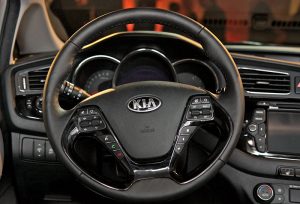 Most cars come standard with power steering these days, but what exactly does that mean? Here’s a closer look at what power steering is and how it works.
Most cars come standard with power steering these days, but what exactly does that mean? Here’s a closer look at what power steering is and how it works.
How Power Steering Works
Power steering is when hydraulic or electric actuators control energy to the steering mechanism. This means that the driver can use less effort to turn the steering wheels when driving at normal speeds. There are several parts involved in your car’s power steering that help it function properly.
The pump provides the hydraulic power for the steering. This is controlled by the car’s engine via a belt and pulley system. The pump has a set of retractable vanes that spin inside an oval-shaped chamber. As the vanes spin, they slowly pull hydraulic fluid in and then force it into the outlet at high pressure.
The next part that’s required in power steering is the rotary valve. The rotary valve senses force on the steering wheel. When you aren’t using your steering wheel, you don’t need power steering. It’s only when you apply pressure that the rotary valve involves the rest of the power steering system. The steering gear is attached to the rotary valve. This helps the wheels turn without much effort.
The History of Power Steering
Power steering was first installed into a vehicle in 1876 by a man named Fitts. The next power steering system wasn’t installed until 1903 when it was put in a Columbia five-ton truck.
While many engineers tried to patent and manufacture other types of power steering for the commercial market after that, it wasn’t until World War II that it was brought to the masses. During the war, the U.S. and British military wanted something that made it easier to steer the heavy armored cars and tanks.
The first commercial car company to debut power steering was Chrysler when it placed it in the Chrysler Imperial in 1951. General Motors then introduced it in its 1951 Cadillac models. Most new vehicles these days have power steering, with trends leaning toward front-wheel drive, wider tires, and greater vehicle mass, all of which increase the need for power steering assistance.
What Would Driving Feel Like Without Power Steering?
When power steering became standard in new vehicles, cars became heavier and lower to the ground. Trying to drive a modern car without power steering would be a tough workout and much more difficult than it was decades past.
Before power steering became the norm, cars usually had steering wheels that were much larger in diameter. This gave drivers a little bit more leverage when turning the wheel. Without power steering, you have to turn the wheel a lot more, and it takes much longer to turn than it does now. A car without power steering isn’t as responsive in turning or adjusting the wheels as a car with power steering.
Most seasoned drivers can remember a time when power steering was a luxury. Thanks to modern technology in auto manufacturing, driving is much easier and much more enjoyable.
Image via Flickr by loubeat






 Warranties include 10-year/100,000-mile powertrain and 5-year/60,000-mile basic. All warranties and roadside assistance are limited. See retailer for warranty details.
Warranties include 10-year/100,000-mile powertrain and 5-year/60,000-mile basic. All warranties and roadside assistance are limited. See retailer for warranty details.